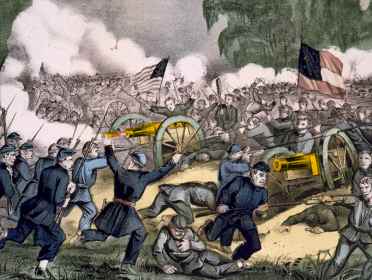Events that led to the American Civil War

Table of Contents
- The United States Constitution of 1788 and Slavery
- Social and Economic Development in the South and North
- Missouri Compromise and Nullification Crisis
- Tensions between the South and North and Collapse of the Old Second Party System
- Victory of Abraham Lincoln in the United States Presidential Election of 1860
The United States Constitution of 1788 and Slavery
Slavery issue that exploded in the 1850’s was the root cause of the American Civil War but the origin of the dispute between the South and North that made the military combat unavoidable can be traced back to the American Revolutionary War (1775-1783). The United States Constitution (1788) that became the leading model for modern democracies worldwide embodied a paradox. It introduced many natural rights and personal liberties that became the core of the US political values at the same time as it recognized the institution of slavery by allowing each state to regulate slavery within its jurisdiction. On the other hand, the slave states would never have joined the Union without explicit acknowledgment of their right to regulate slavery.
Social and Economic Development in the South and North
By the early 19th century, all Northern states passed the laws to abolish slavery, while slavery in the South continued to grow, especially after the invention of the cotton gin and increasing demand for raw cotton in Britain. At the same time became obvious the differences in social and economic development along the sectional lines which resulted in diminished influence of the South on the national government. The population in industrializing Northern states grew at a higher rate than Southern population due to high birth rate and European immigrants. Predominantly rural South had rapid growth of population as well but it had fewer European immigrants and little industry. By 1820, the South had only little more than 40 percent of votes in the House of Representatives.
Missouri Compromise and Nullification Crisis
The South threatened secession already in 1819 when the North tried to force the slave state of Missouri to abolish slavery when it applied for admission to the Union. The disagreement was settled with the Missouri Compromise in 1820 which prohibited slavery north of the parallel 36º30’ except within the boundaries of Missouri. However, the tensions between South and North continued to rise. The South was severely hit by the Tariff of 1828 which wanted to protect the Northern industries from imported goods. Firstly, the southerners had to pay more for the imported products and secondly, they had difficulties exporting their cotton in Britain. Under the impression that they are sacrificing their export economy on behalf of Northern industry, South Carolina declared the Tariff null starting the Nullification Crisis (1832-1833).
Tensions between the South and North and Collapse of the Old Second Party System
The Nullification Crisis ended with South Carolina’s repeal of its Nullification Ordinance but the southerners became increasingly worried about the emergence of abolitionist movement in the North in the 1830’s. On the other hand, the Northern states believed in the “Slave Power Conspiracy” that was expanding slavery throughout new territories on the expense of free labor. The Compromise of 1850 that introduced the Fugitive Slave Act and the Kansas-Nebraska Act of 1854 that revoked the Missouri Compromise furthered polarization between South and North, while the old Second Party System collapsed.
Victory of Abraham Lincoln in the United States Presidential Election of 1860
The victory of the Republican Abraham Lincoln in the United States Presidential election of 1860 made the war between South and North inevitable because of the Republican Party’s “Free Soil, Free Labor, Free Men” ideology. The southerners who feared that Lincoln will make an end to slavery immediately launched a campaign for secession, while the northerners considered secession illegal and worried that it would lead to fragmentation of the United States.




